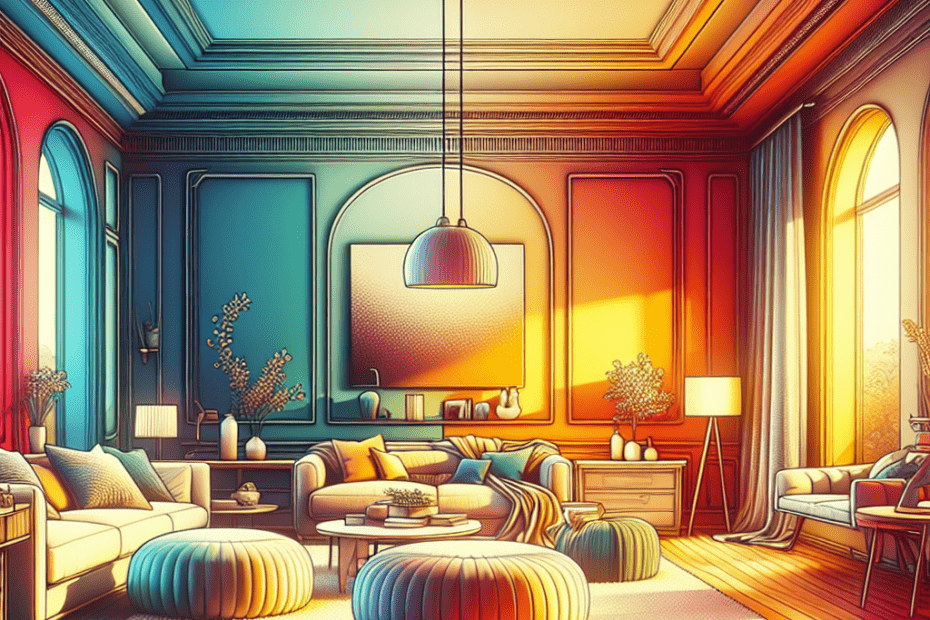“`html
Mixing warm and cool colors in a single room can transform a simple space into a vibrant tapestry of hues that delight the senses. They may wonder how to achieve this delicate balance without the colors clashing or overpowering. By using thoughtful strategies and creative combinations, anyone can design a space that exudes warmth and tranquility simultaneously.
The Science Behind Color Mixing
Warm colors like red, orange, and yellow are known to evoke feelings of warmth and passion, while cool colors like blue, green, and purple are calming and soothing. According to a study by the Pantone Color Institute, 62% of people perceive spaces with a mix of these colors as more dynamic and interesting. This effect occurs because warm colors tend to advance, demanding attention, while cool colors recede, providing a serene background.
Creating Contrast and Harmony
To successfully mix warm and cool colors, contrast is key. This means placing warm tones against a backdrop of cooler hues or vice versa. For instance, a warm orange sofa can pop against a cool, muted blue wall. They should be mindful, however, to incorporate elements like furniture or art that tie these colors together, maintaining harmony.
Accents and Accessories
Another effective method is using accessories. They can bring in warm or cool tones through items like throw pillows, rugs, or artwork. A cool-colored vase on a warm-toned table or a set of warm-colored candles on a cool mantel can create balance. Incorporating natural elements such as wood or plants also helps to ground these colors, providing a neutral balance that complements both.
Transitional Spaces and Color Flow
When they blend colors, especially in connected spaces, ensuring a fluid color flow is crucial. They can do this by using transitional colors that bridge warm and cool tones. For example, using a deep green—a color that can read as both warm and cool—can fill the gap between a warm yellow kitchen and a cool blue living room.
| Color Type | Examples | Effect |
|---|---|---|
| Warm Colors | Red, Orange, Yellow | Energetic, Inviting |
| Cool Colors | Blue, Green, Purple | Calming, Soothing |
| Transitional Colors | Deep Green, Maroon | Balanced, Harmonizing |
The Importance of Light
Lighting plays a pivotal role when mixing warm and cool colors. Natural light can enhance the brightness and depth of colors, making them appear more vibrant. Artificial lighting can skew colors either towards a warmer or cooler tone, depending on the bulbs used. They should test their color choices under different lighting conditions to see how they change throughout the day.
Statistics and Insights
Based on a survey conducted by Houzz in 2023, over 45% of homeowners expressed that using a mix of warm and cool tones made spaces feel more versatile and comfortable. Furthermore, rooms that effectively use color mixing reportedly increase homeowner satisfaction by 30%, as they create spaces that can adjust to different moods and purposes.
Practical Tips for Beginners
For those new to interior design, starting with a neutral base is helpful. Walls painted in soft gray or beige provide a canvas to apply warm and cool accents without overwhelming the senses. They might experiment with different patterns and textures as well, combining a cool geometric pillow with a warm floral one to add interest and depth.
Key Takeaways
- Warm colors advance in space, creating a sense of energy.
- Cool colors recede, promoting calmness and tranquility.
- Contrast and harmony are vital to mixing colors effectively.
- Lighting significantly impacts how colors are perceived.
- Start with a neutral base and add colorful accents thoughtfully.
FAQ
How do they start mixing warm and cool colors?
They should start by determining the primary function of the room and choose a base color accordingly. From there, they can add contrasts through furniture and accessories.
Can warm and cool colors be mixed in small rooms?
Yes, mixing colors can actually add dimension to small spaces. Using lighter shades of warm and cool colors can help the room feel larger.
Are there colors that comfortably bridge warm and cool hues?
Yes, colors like deep green or maroon often have dual undertones and can serve as transitional shades between warm and cool tones.
What if the colors still clash?
If colors clash, they can introduce neutral elements or consider adjusting the balance of the colors by reducing one tone’s presence.
How does furniture play a role in mixing colors?
Furniture can act as a focal point that incorporates both color palettes, such as a warm-toned wood piece with cool-colored upholstery.
“`
